A MCDM Analysis of the Roşia Montană Gold Mining Project
Abstract
:1. Introduction
2. The Decision-Making Context
3. The Stakeholders
4. Methodology
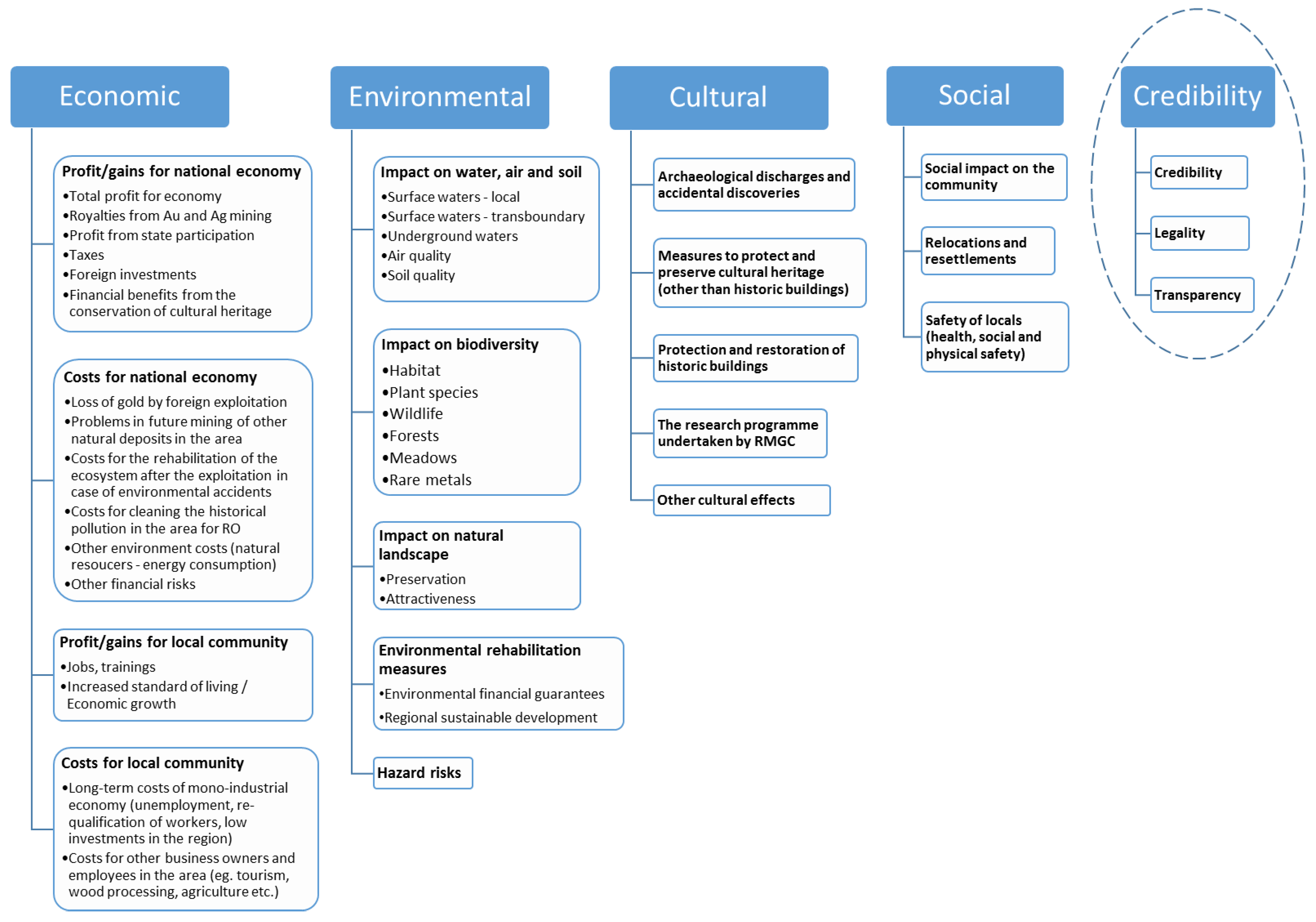
- Alternative 1 (Alt. 1). The updated project with the provisions from the 2013 Agreement between RMGC and the Romanian Government (which was also debated by the Special Parliamentary Committee) [33].
- Alternative 2 (Alt. 2). The Zero alternative, which implies that the mining project would be dropped, but nothing else would be done instead in Roșia Montană. It is a non-action alternative and it was assessed from a series of documents, among which: the Environmental Impact Assessment for Roșia Montană Project (EIA) documentation submitted by the company [34], the report from the Hungarian Ministry of Environment and Waters [35], following the Convention on Environmental Impact Assessment in a Transboundary Context, a study from the Romanian Academy [36], the Special Committee’s Report [37] and other expert studies.
- Alternative 3 (Alt. 3). The project in its initial form, with the provisions from the 1999 Exploitation License [38] and its additional agreements.
- Alternative 4 (Alt. 4). The alternative of touristic development in the Roşia Montană area. On the Chamber of Deputies webpage, a forum [20] for debate on the Roşia Montană issues has a thread destined for discussing alternatives other than the RMGC project for the development of the area. The tourism alternative seems to be the most popular among the civil society sector, including among research institutions such as The Academy for Economic Studies or the Romanian Academy. Citizens, local NGOs and the Save Roşia Montană campaign have been promoting this alternative through an annual activist festival in Roşia Montană, lobbying for the inclusion of its cultural heritage on the UNESCO list of protected heritage sites. An ample study [21] on the touristic potential of development of the area was conducted by the National Institute of Research and Development in Tourism during 2004–2006, financed through the Poland and Hungary: Assistance for Restructuring their Economies (PHARE) program and the Ministry of Education and Research. The institute is responsible with elaborating strategies and impact studies for touristic development throughout Romania, many of their results leading to regional development strategies and financed by the Ministry of Tourism. However, the five volumes report is only accessible at the National Institute of Research and Development in Tourism archives.
- [−1, 0] most probably negative consequences (or best case none), but the intensity is unknown
- [0,1] most probably positive consequences (or no consequences), but the intensity is unknown
- 0 neutral
- −1 negative (e.g., environmental costs such as the high amount of energy and other natural resources consumed for the project are a certain negative impact)
- 1 positive, which was never used, taking into consideration that it would also imply a relative consensus among experts
- [−1, 1] where experts are almost equally divided and it is difficult to say whether the consequence would be good or bad; or where we do not have enough reliable data for such predictions.
5. Evaluation and Analysis of Alternatives
5.1. Scenario 1
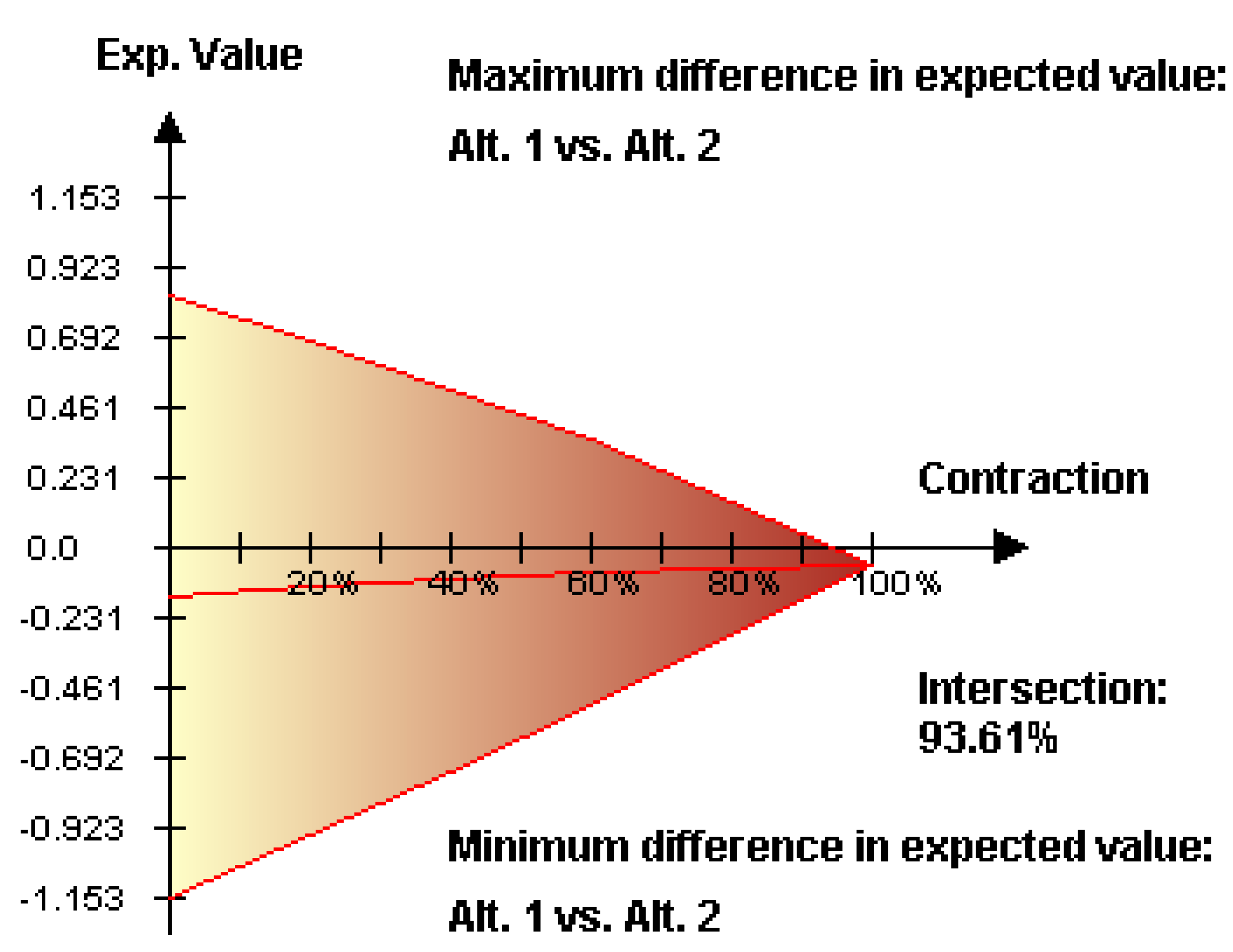

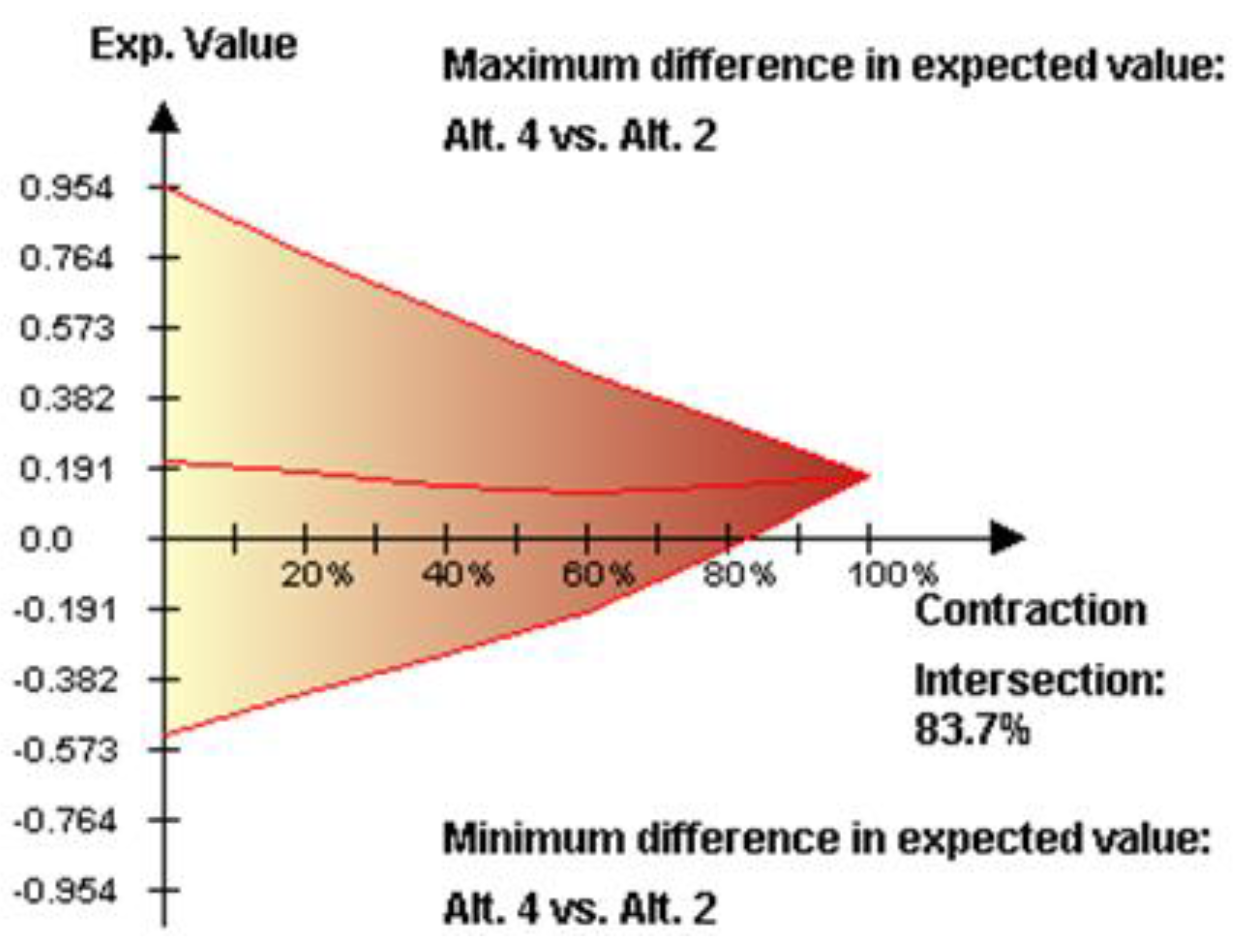
- -
- Alt. 3 (The project in the initial form, with the provisions from the 1999 license) is the least advantageous of the four, and can be discarded (at a contraction level of 85% there is no overlap with the others, and the values are negative and lowest).
- -
- Alt. 4 (Tourism) appears to be the optimal decision in this scenario.
- -
- Alt. 1 (The mining project in its updated form) and Alt. 2 (No mining project, nothing instead) overlap entirely, which means that in this scenario there is not enough data to differentiate between them, the consequences of each option being rather comparable. Figure 3 confirms that the difference between Alt. 1 and Alt. 2 is insignificant and that more detailed data is needed in order to better comparatively assess the two options.
5.2. Sensitivity Analysis
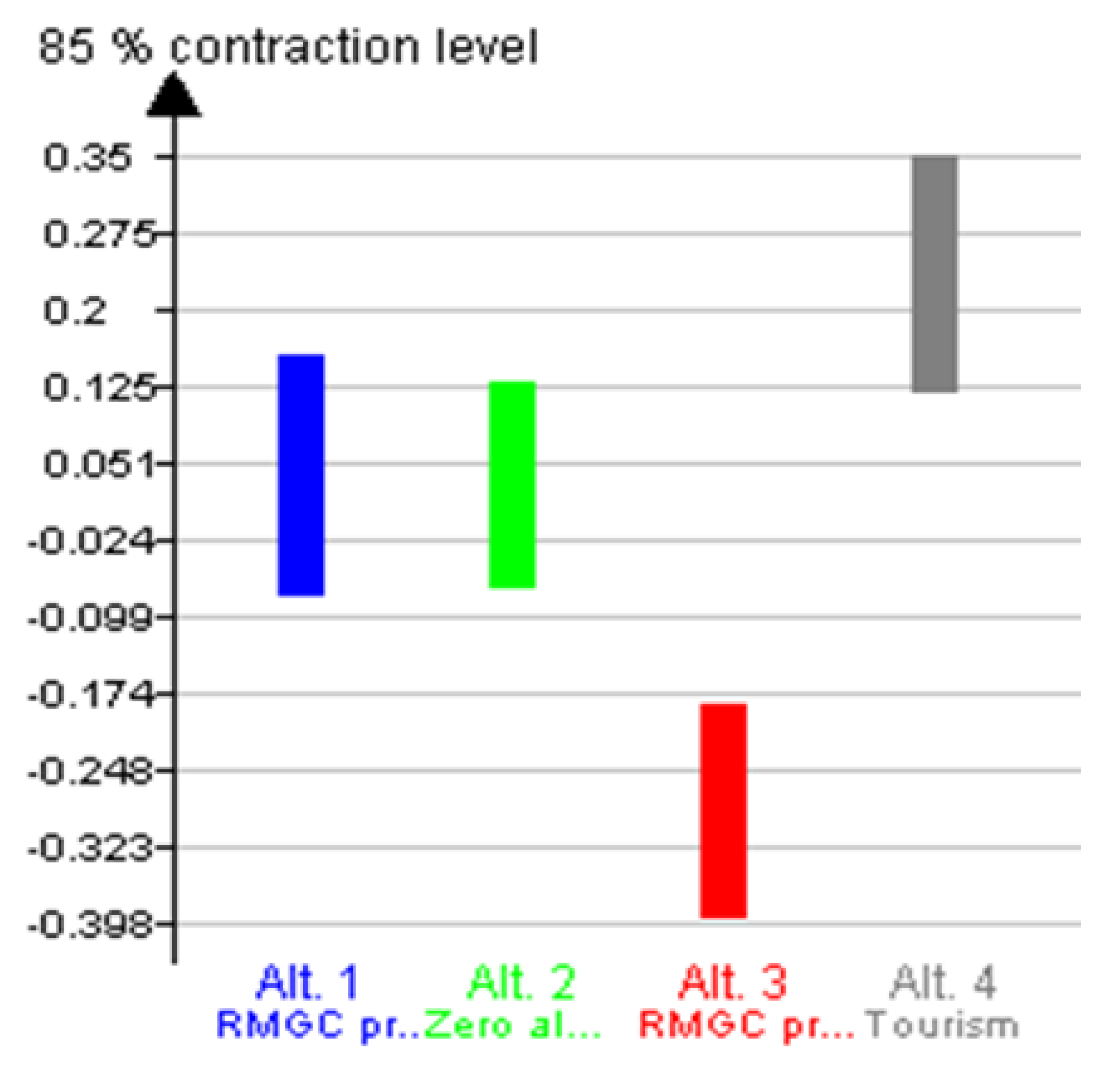
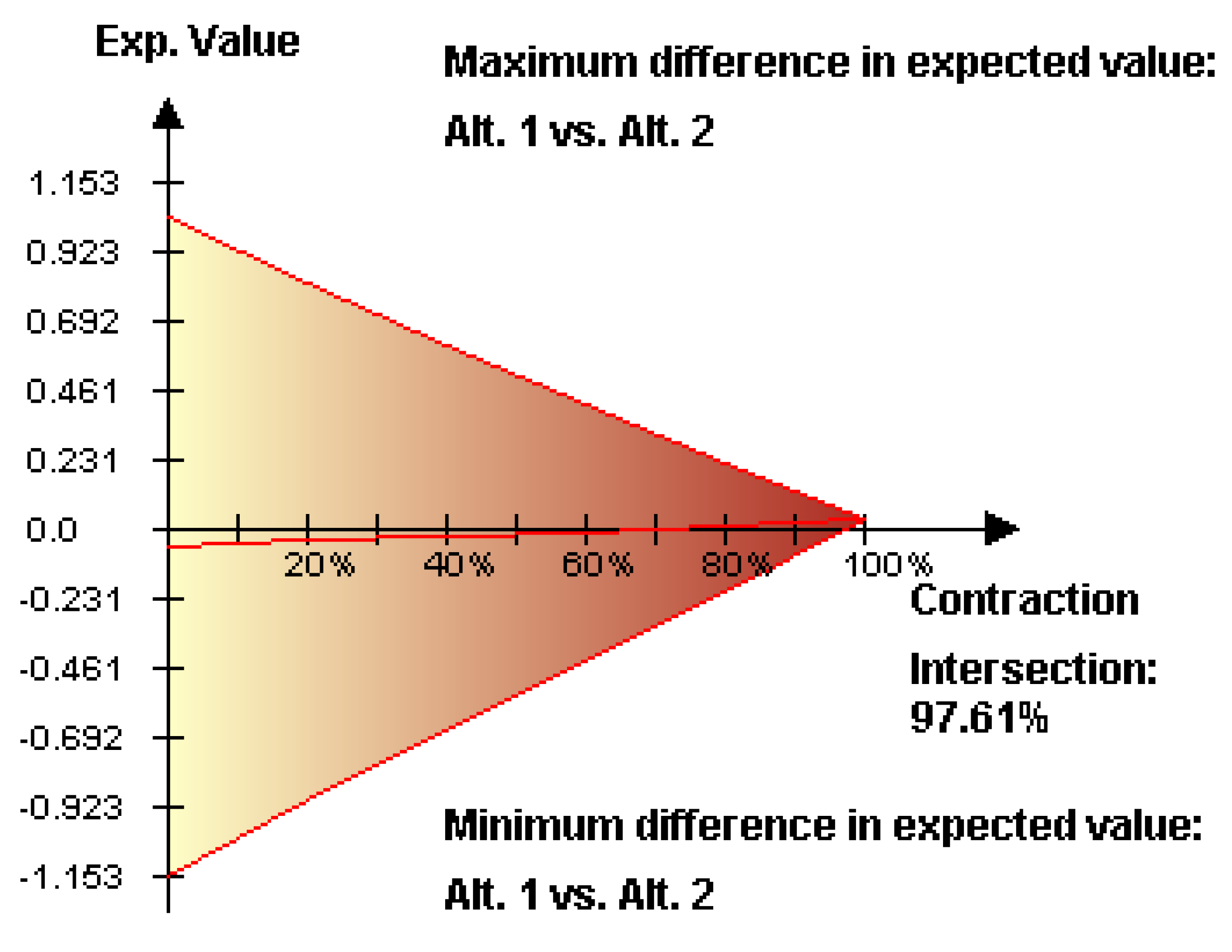

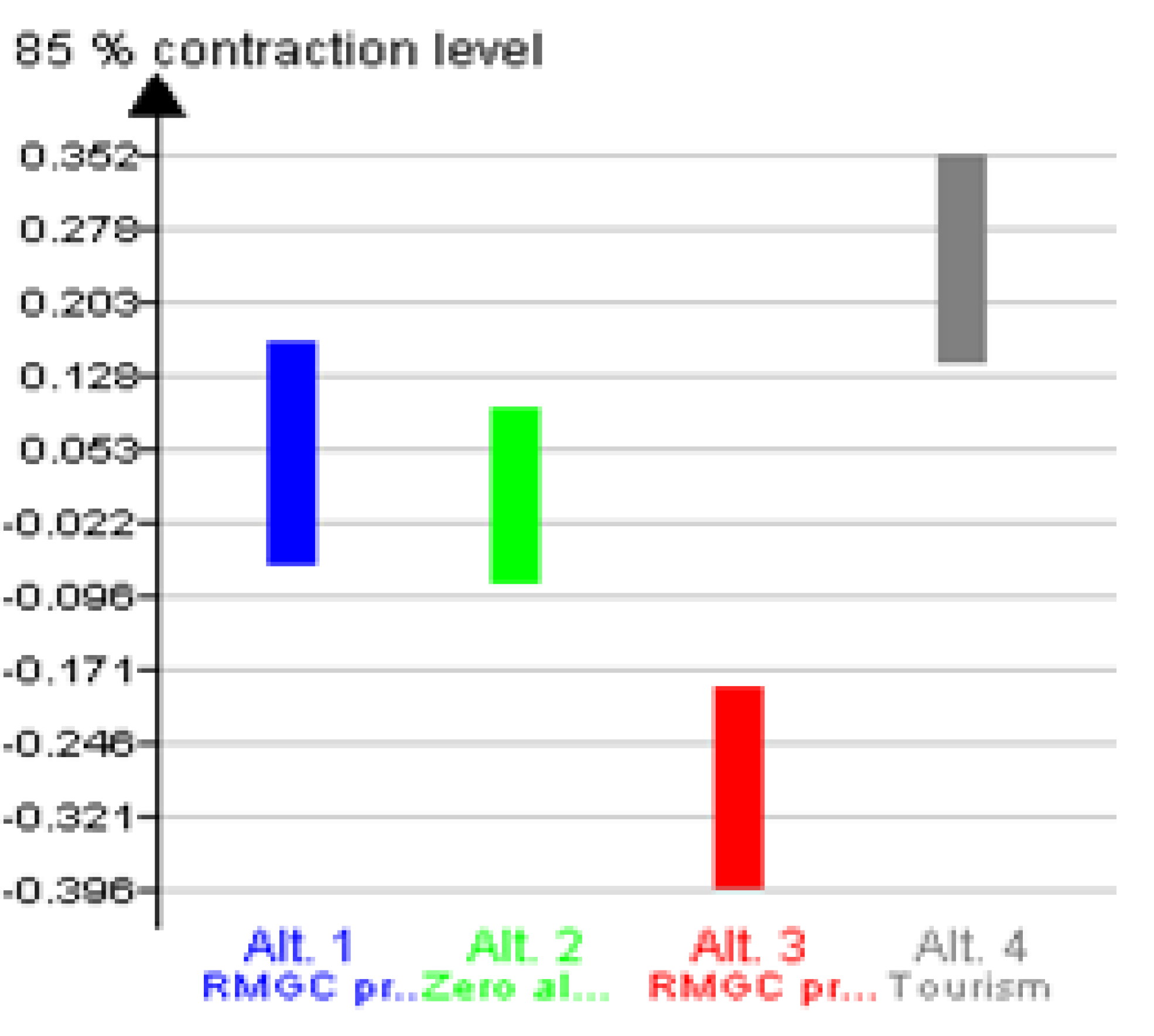
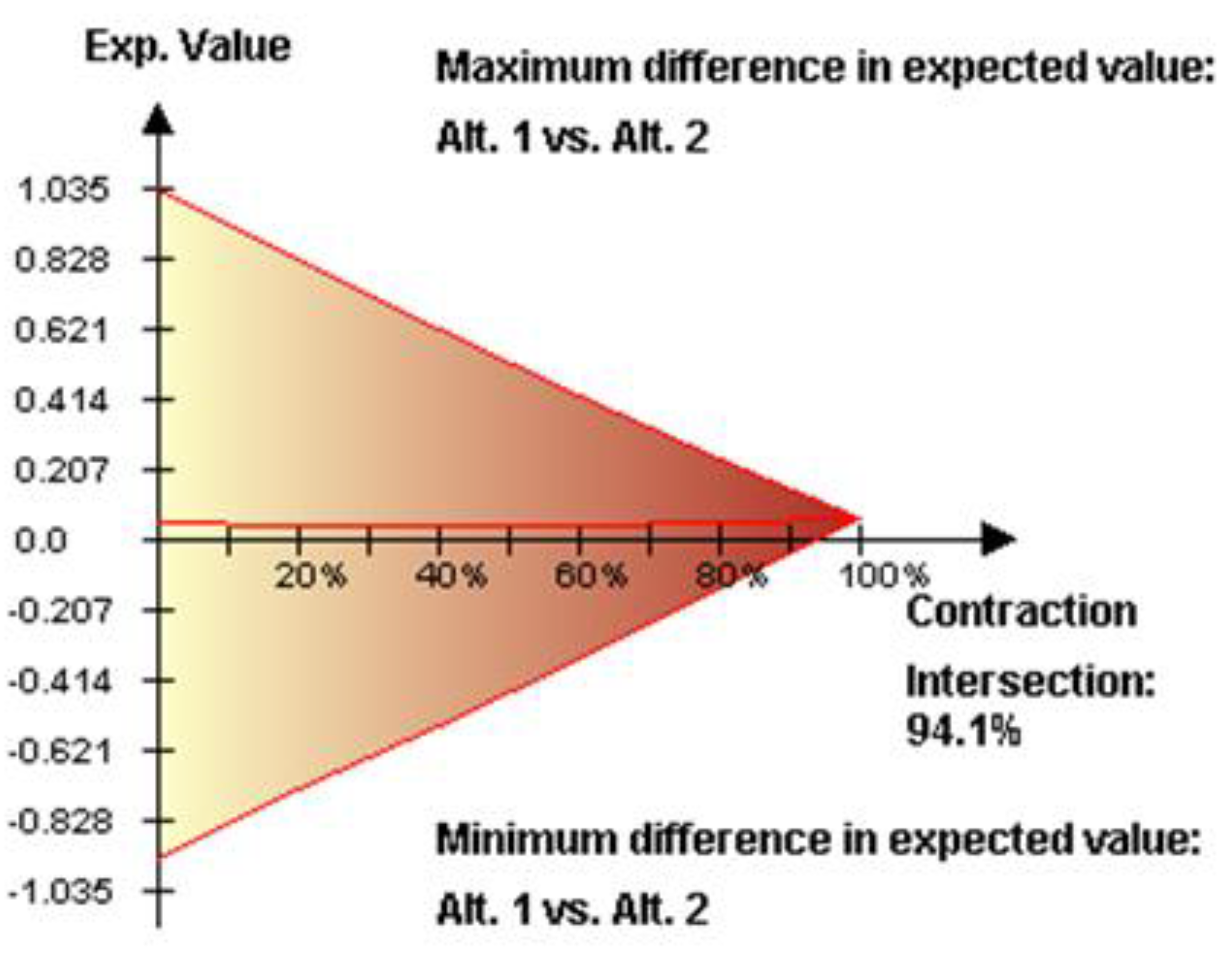
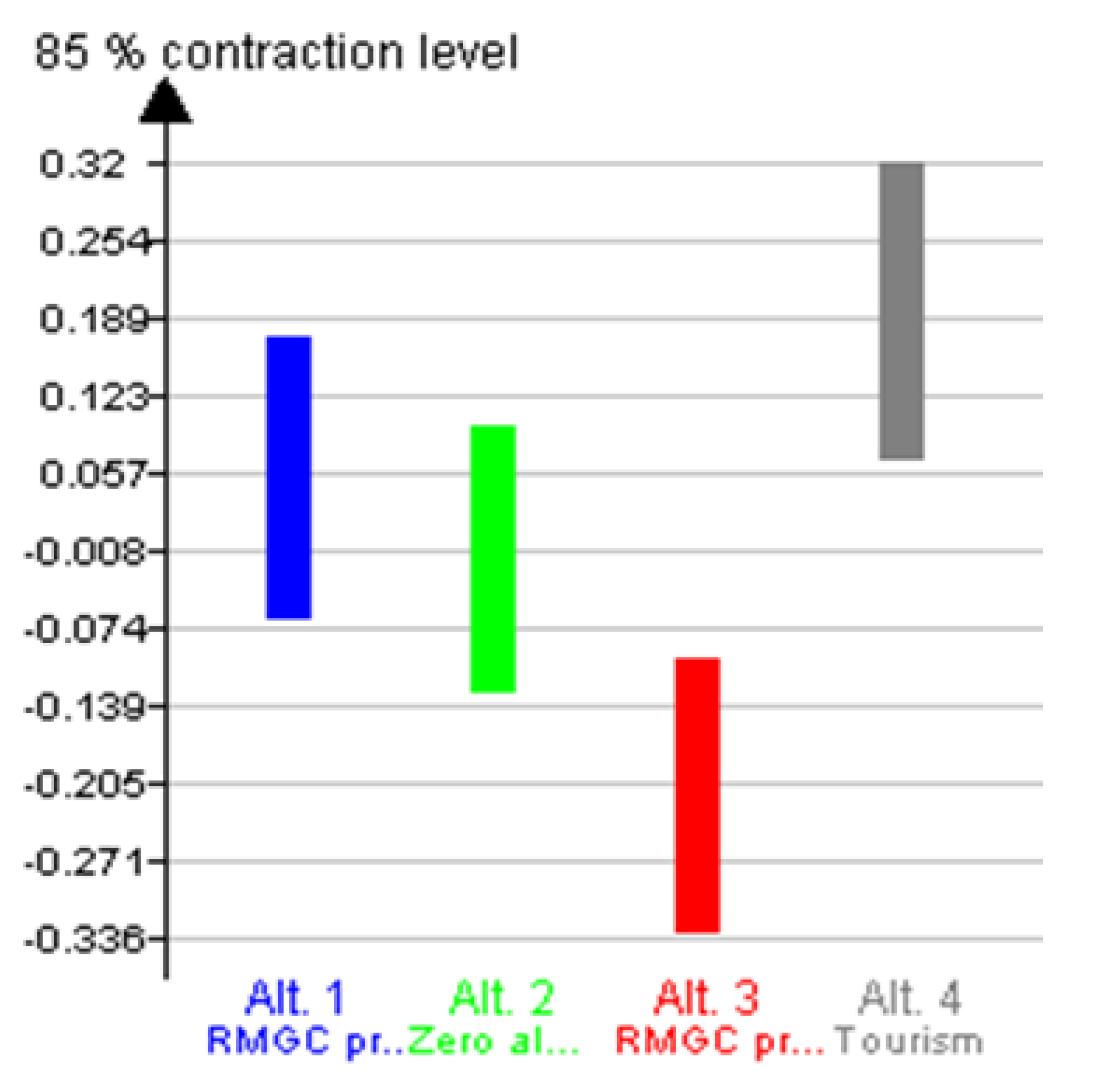
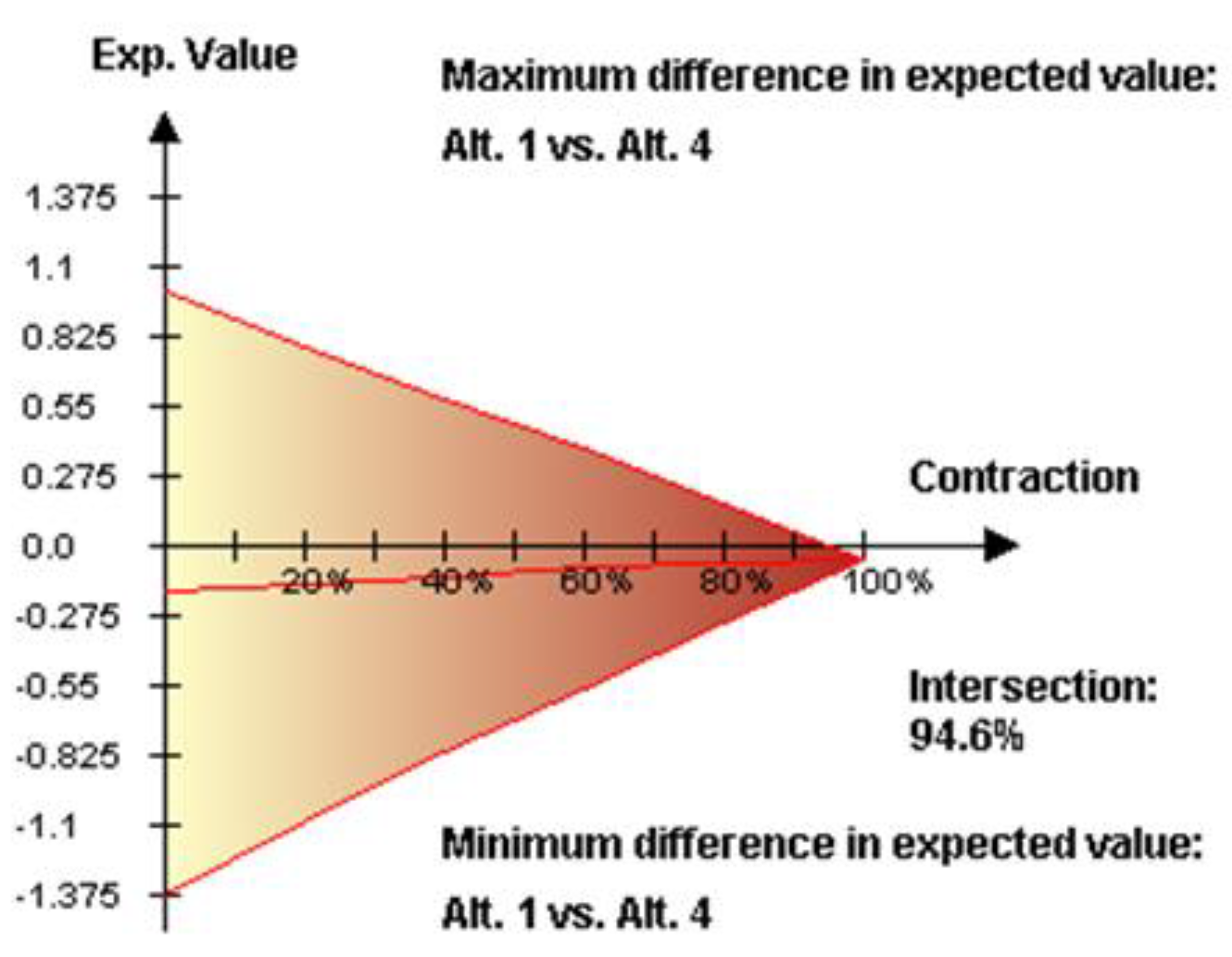
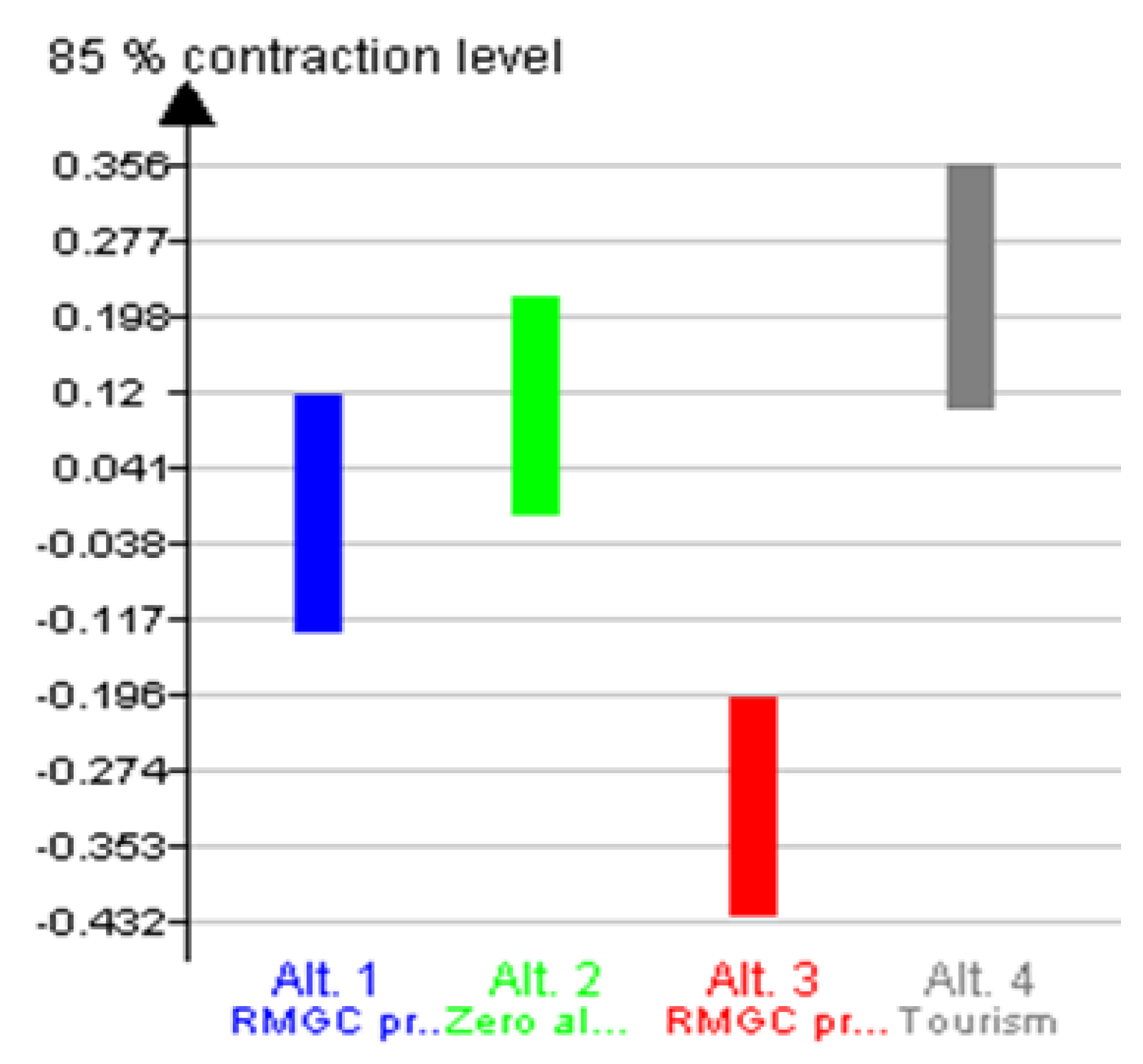
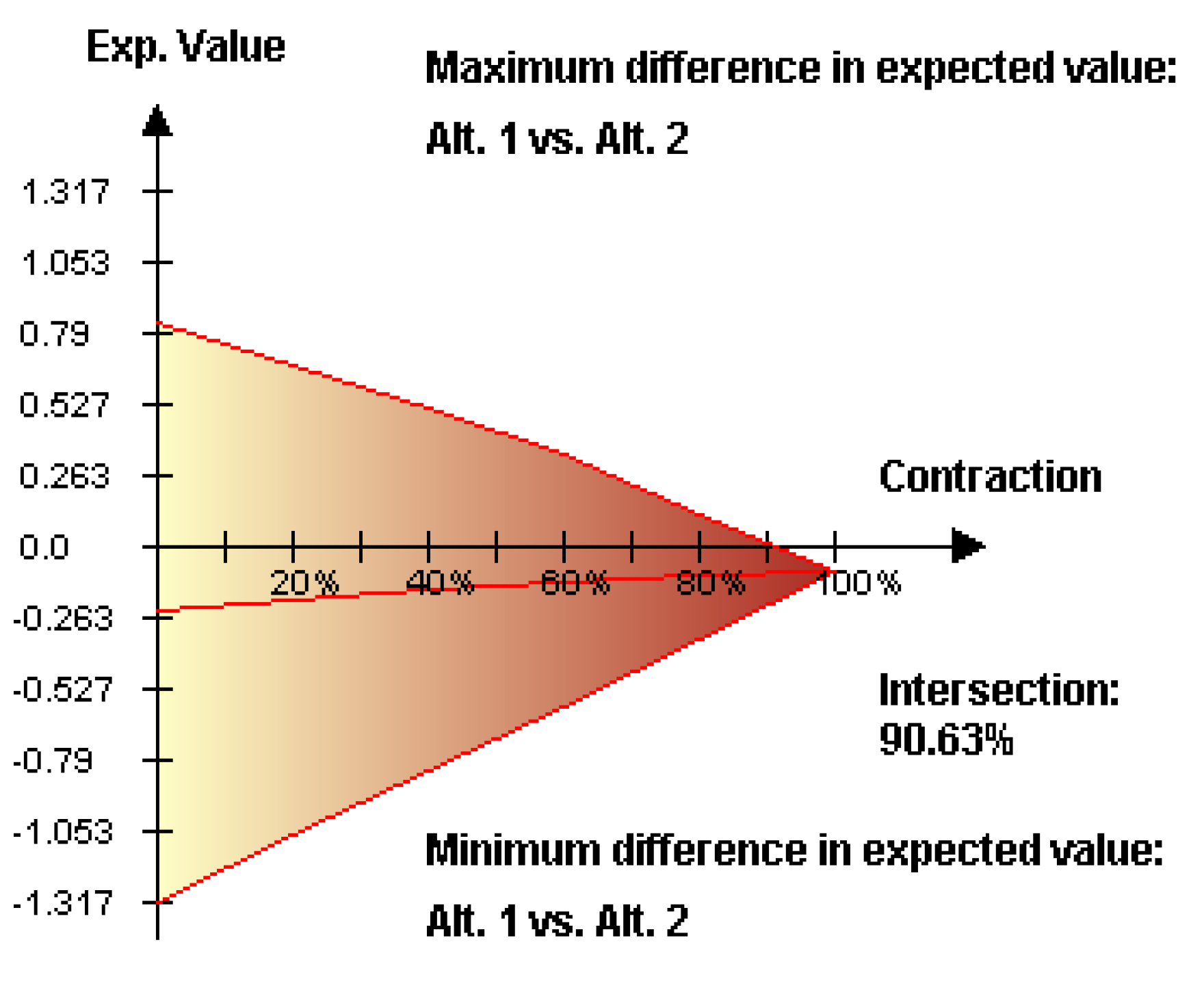


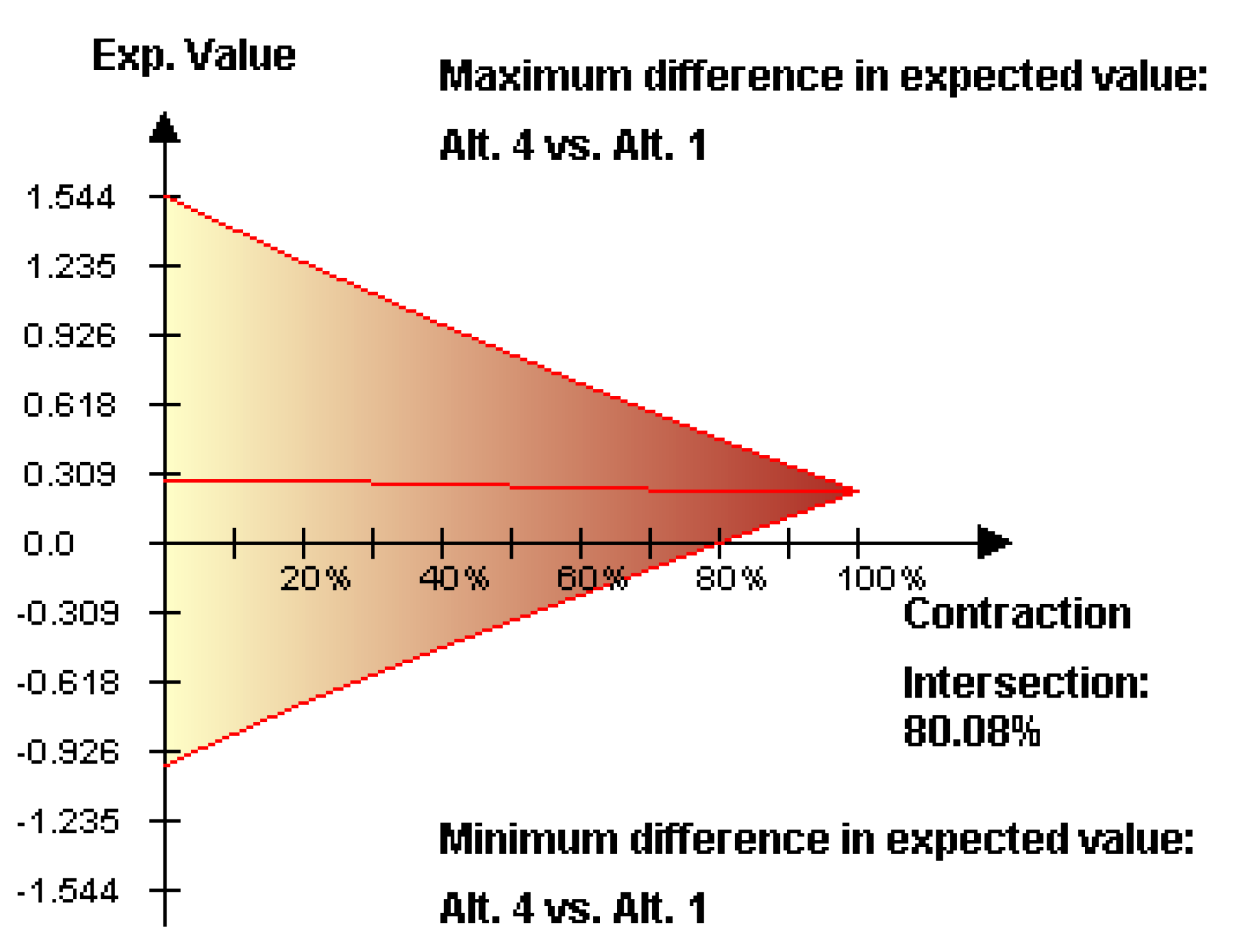
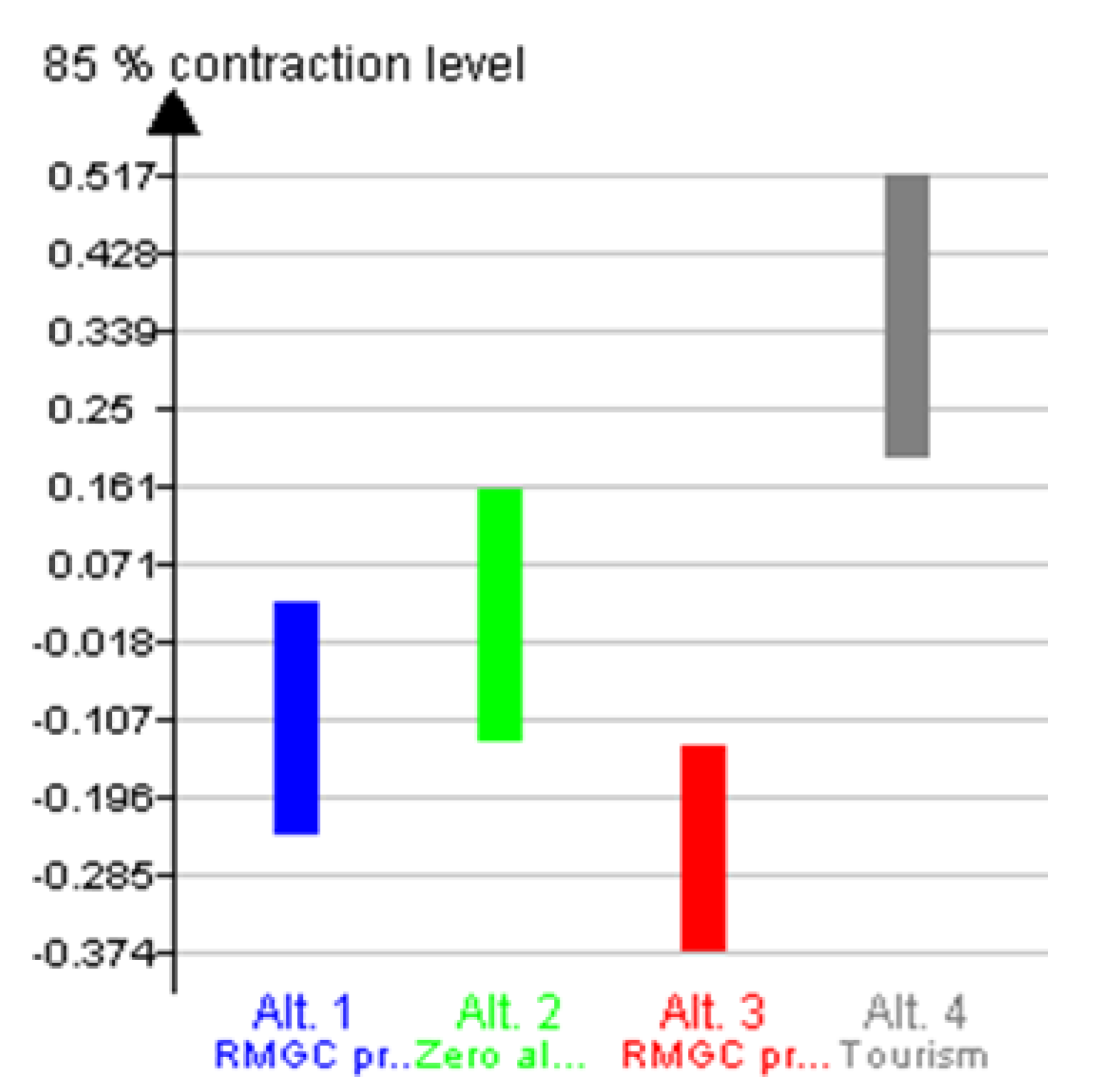

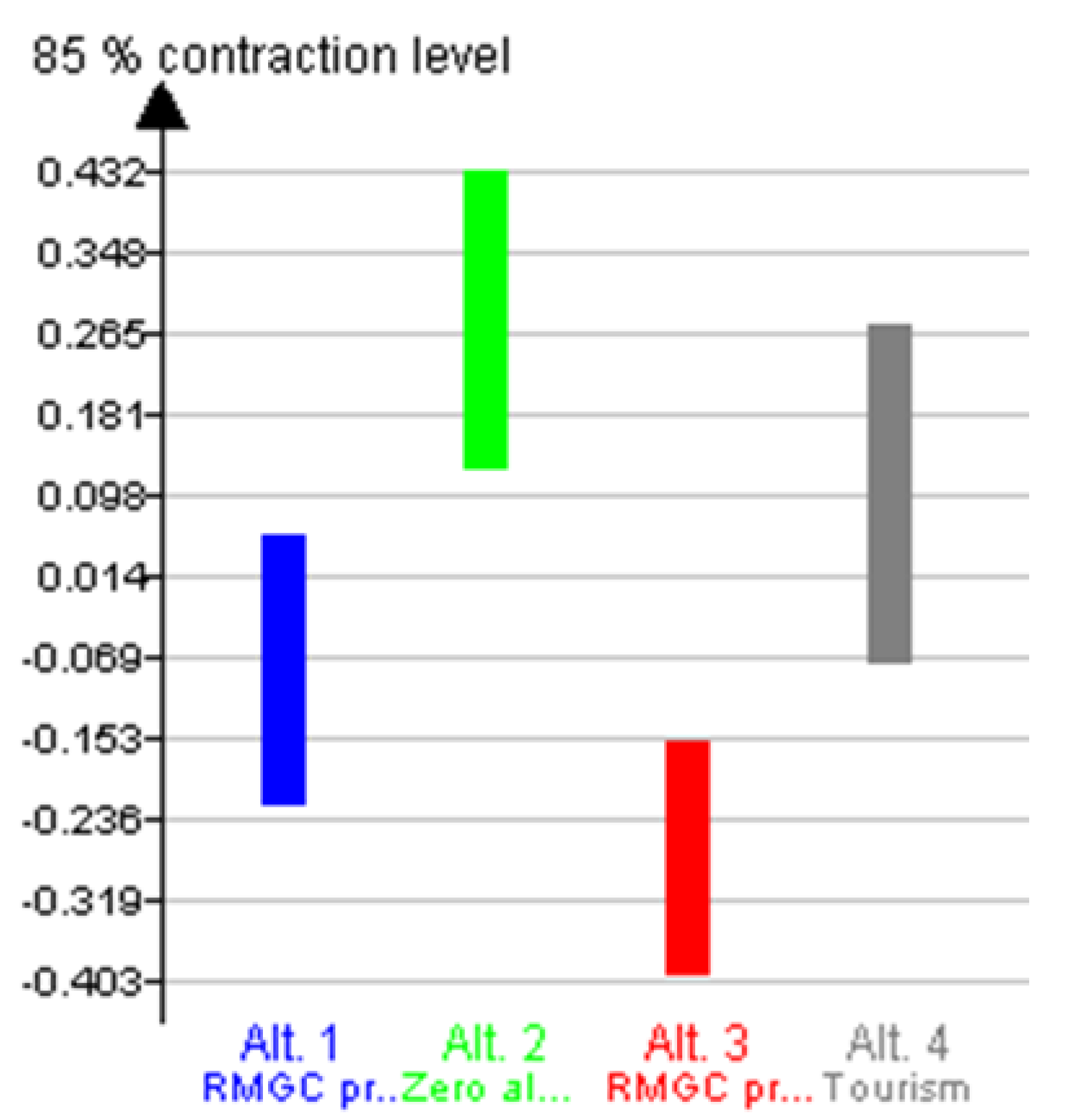

5.3. Other Scenarios Advanced in the Public Debates:
- If a different technology is used in the exploitation, skipping the cyanide leaching process and the toxic tailings raising the environmental concerns, weights would be impossible to estimate within Alt. 1, since Roşia Montană Gold Corporation is not willing to modify the technology. The entire business plan, feasibility and investment studies are built on the present technology. A separate alternative backed by a feasibility study of alternative exploitations of the deposits should be analyzed by the Romanian state or by other investors.
- If Corna Valley is not used for the construction of the tailings management facility, the risk of toxic tailings permeating the underground waters would considerably diminish, according to the National Institute of Geology. In the multi-criteria tree, the difference would be visible by changing the possible outcomes for the subcriterion Underground waters, within Environment, in the case of the project approval. The interval [−1, 0] is changed with a most likely point 0. The change does not affect the final cardinal ranking of the alternatives.
- If mining legislation is adopted so as to ease the approval of environmental permits needed for the implementation of Alt. 1, the RMGC project, the risks and benefits of this alternative increase proportionally, as they can be replicated in other similar future projects. Also, taking into consideration the release of new licenses for exploration by the National Agency for Mineral Resources, the precedent of the Roşia Montană project can lead to similar choices to be employed in the future by investors.
- If we consider the documentation provided by the National Institute of Research and Development in Tourism [21] on Alt. 4, we can see that their research and cost-benefit analysis aim at a touristic development of not only the Roşia Montană area, but also of other areas in Apuseni Mountains affected by mining closures after Romania’s accession to the European Union. A successful sustainable development through tourism could as well be replicated.

6. Research Limitations
7. Conclusions
- Research in cooperation with other EU member states of alternative technologies leading to environmentally safer mining—see researcher Jack Goldstein’s [10] (pp. 17–18) proposed method for Roşia Montană, which uses sodium thiosulfate as the main reactive substance for solubilization; cost-benefits analysis; sustainability; and range of applicability.
- Perform an even more elaborated analysis by expanding the multi-criteria tree with more detailed technical information, leading to a wider number of branches and subcriteria, after gaining more input on: touristic development, local authority plans in case the project is rejected for good, public opinion preferences and perceived risks and needs.
- Introduce more alternatives for sustainable development in areas where state-funded mining was ceased.
Acknowledgments
Author Contributions
Conflicts of Interest
References
- Gabriel Resources Ltd. Gabriel Seeks Amicable Resolution Over Mining Dispute. Available online: http://gabrielresources.com/documents/GBURelease_Amicableresolutionsought_200115.pdf (accessed on 20 January 2015).
- Neagu, A. Sondaj SOCIOPOL: 70% dintre români cred că decizia privind Roșia Montană trebuie luată după o dezbatere parlamentară, 60% consideră că soluția pentru problema câinilor fără stăpân este eutanasierea. Available online: http://www.hotnews.ro/stiri-esential-15578385-sondaj-sociopol-70-dintre-romani-cred-decizia-privind-Roșia-Montană-trebuie-luata-dupa-dezbatere-parlamentara-60-considera-solutia-pentru-problema-cainilor-fara-stapan-este-eutanasierea.htm (accessed on 14 September 2014).
- Roşia Montană Gold Corporation. Geology of Roşia Montană. Available online: http://en.rmgc.ro/Roşia-Montană-project/geology.html (accessed on 2 September 2014).
- Roşia Montană Gold Corporation. Memorandum. Available online: www.mmediu.ro/protectia_mediului/Roşia_Montană/pdf/memoriu_prezentare.pdf (accessed on 3 September 2014).
- Romanian Parliament. Hotărârea nr. 8/2003 pentru constituirea Comisiei comune speciale privind efectuarea unei analize asupra Proiectului de dezvoltare minieră Roşia Montană. Available online: http://www.jurisprudenta.com/lege/hotarare-8-2003-166mm/ (accessed on 10 February 2015).
- Marinescu, V. Desi Raportul Comisiei parlamentare nu dă undă verde investiției, autorii proiectului “Roşia Montană” se și văd câștigători. Available online: http://www.curierulnational.ro/print/15612 (accessed on 16 October 2014).
- Roșia Montană Gold Corporation. Environmental Impact Assessment. Available online: http://en.rmgc.ro/Roşia-Montană-project/environment/environmental-impact-assessment.html (accessed on 2 October 2014).
- Marincea, A. Argumentele pro şi contra proiectului de exploatare de la Roşia Montană. Available online: http://www.openpolitics.ro/Roşia-Montană/argumente-pro-si-contra-Roşia-Montană.html (accessed on 6 November 2013).
- Romanian Parliament. The Special Senate and Chamber of Deputy Joint Committee on Approval of the Draft Bill on Certain Measures related to the Exploitation of the Gold and Silver Deposits from Roşia Montană and Stimulation and Facilitation of Mining Development in Romania. Available online: http://www.cdep.ro/pls/parlam/structura.co?cam=0&idc=205 (accessed on 16 September 2014).
- Romanian Parliament. Raportul final al Comisiei Speciale pentru Roșia Montană. Available online: http://media.hotnews.ro/media_server1/document-2013-11-11-16004020-0-raportul-final-comisiei-speciale-pentru-rosia-montana.doc (accessed on 12 November 2013).
- Gabriel Resources Ltd. Available online: http://www.gabrielresources.com/site/index.aspx (accessed on 30 August 2013).
- Roșia Montană Gold Corportation. Acid rock drainage potential of various areas from Roșia Montană Project, 30 September 2010. Available online: http://en.rmgc.ro/Content/uploads/eia-en/Annex_NE_Cap4.1_03-ARD-Potential_En.pdf (accessed on 4 October 2014).
- Directive 2006/21/EC of the European Parliament and of the Council of 15 March 2006 on the management of waste from extractive industries and amending Directive 2004/35/EC. Available online: http://eur-lex.europa.eu/legal-content/EN/TXT/HTML/?uri=CELEX:32006L0021&from=EN (accessed on 20 September 2014).
- Toader, E. Directorul Institului Geologic al României: Proiectul Roşia Montană nu este în avantajul statului. Available online: http://www.mediafax.ro/social/directorul-institului-geologic-al-romaniei-proiectul-rosia-montana-nu-este-in-avantajul-statului-11480660 (accessed on 15 October 2013).
- Directive 2008/98/EC of the European Parliament and of the Council of 19 November 2008 on waste and repealing certain Directives. Available online: http://eur-lex.europa.eu/legal-content/EN/TXT/PDF/?uri=CELEX:32008L0098&from=EN (accessed on 20 September 2014).
- Pascaru, M. Glocalizare românească. Impactul comunitar al proiectului Roşia Montană Gold Corporation; Limes Publishing House: Cluj-Napoca, Romania, 2013. [Google Scholar]
- Stefan, O. Interview with Dan Perjovschi. Available online: http://www.artmargins.com/index.php/5-interviews/728-interview-with-dan-perjovschi (accessed on 25 October 2013).
- Goţiu, M. Afacerea Roşia Montană; Editura Tact: Cluj-Napoca, Romania, 2013. [Google Scholar]
- Stoica, C.A. Opinia Publică despre Proiectul Roşia Montană şi Gazele de Şist. Available online: http://voxpublica.realitatea.net/politica-societate/opinia-publica-despre-proiectul-roșia-montană-si-gazele-de-sist-101065.html (accessed on 11 December 2013).
- Camera Deputaților - Proiectul Roșia Montană Forum. Available online: http://www.cdep.ro/informatii_publice/forum.dispSub?catid=2 (accessed on 16 September 2014).
- Maiorescu, G. (Coord.). Model de dezvoltare turistică a zonei miniere Zlatna-Bucium-Roșia Montană-Baia de Arieș în perspectiva dezvoltării durabile, ca alternativă a activității monoindustriale extractive în declin; Institutul Național de Cercetare-Dezvoltare în Turism: București, Romania, 2004; Volume 5. [Google Scholar]
- Olaru-Zăinescu, S. Dezvoltare durabilă alternativă mineritului la Roşia Montană. Analiza resurselor şi elemente de strategie. Asociaţia Alburnus Maior, 2006. Available online: http://www.rosiamontana.ro/img_upload/c77c3453789af5de5049783baaa35f31/studiu_alternative_dezvoltare.doc (accessed on 16 November 2014).
- Uniţi Salvăm Facebook Community. Available online: https://www.facebook.com/unitisalvam (accessed on 28 December 2013).
- Musingwini, C. A review of the theory and application of multi-criteria decision analysis techniques in mine planning. In Proceedings of the Mine Planning and Equipment Selection (MPES), Fremantle, Australia, 1–3 December 2010; The Australasian Institute of Mining and Metallurgy: Melbourne, Australia, 2010; pp. 129–140. [Google Scholar]
- Straka, M.; Bindzár, P.; Kaduková, A. Utilization of the multicriteria decision-making methods for the needs of mining industry. Acta Montanistica Slovaca Ročník 2014, 19, 199–206. [Google Scholar]
- Gelvez, J.; Aldana, F. Mining Method Selection Methodology by Multiple Criteria Decision Analysis—Case Study in Colombian Coal Mining. Available online: http://www.isahp.org/uploads/p744104.pdf (accessed on 4 June 2015).
- Esteves, A.M. Evaluating community investments in the mining sector using multi-criteria decision analysis to integrate SIA with business planning. Environ. Impact Assess. Rev. 2008, 28, 338–348. [Google Scholar] [CrossRef]
- Betriea, G.; Sadiqa, R.; Morinb, K.; Tesfamariama, S. Selection of remedial alternatives for mine sites: A multicriteria decision analysis approach. J. Environ. Manag. 2013, 119, 36–46. [Google Scholar] [CrossRef] [PubMed]
- Erzurumlua, S.; Erzurumlub, Y. Sustainable mining development with community using design thinking and multi-criteria decision analysis. Resour. Policy 2014. [Google Scholar] [CrossRef]
- Danielson, M.; Ekenberg, L.; Idefeldt, J.; Larsson, A. Using a Software Tool for Public Decision Analysis: The Case of Nacka Municipality. Decis. Anal. 2007, 4, 76–90. [Google Scholar] [CrossRef]
- Ding, X.S.; Danielson, M.; Ekenberg, L. Disjoint Programming in Computational Decision Analysis. J. Uncertain Syst. 2010, 4, 4–13. [Google Scholar]
- Riabacke, M.; Danielson, M.; Ekenberg, L. State-Of-The-Art in Prescriptive Weight Elicitation. Adv. Decis. Sci. 2012, 2012, 1–24. [Google Scholar] [CrossRef]
- Acord privind unele măsuri aferente exploatării minereurilor auro-argentifere din perimetrul Roşia Montană. Available online: http://legea.rosiamontana.org/wp-content/uploads/2013/08/2-Acord-vDPIIS_29-07-2013_actualizat-30-07-2013-TC.pdf (accessed on 14 August 2013).
- Environmental Impact Assessment for Roșia Montană Project. Available online: http://en.rmgc.ro/rosia-montana-project/environment/environmental-impact-assessment.html (accessed on 6 September 2014).
- Comentarii pe marginea Studiului de Impact asupra Mediului pentru Proiectul Roșia Montană făcute în baza Convenției Espoo de către Ministerul Mediului și Apelor din Ungaria cu sprijinul unor agenții guvernamentale și a unor organizații non-guvernamentale. Available online: http://www.cdep.ro/img/rosiam/pdfs/comments_hung.pdf (accessed on 6 September 2014).
- Analiza Academiei Române privind proiectul de exploatare minieră de la Roşia Montană—Riscuri privind mediul şi dezvoltarea durabilă a zonei, 2013. Available online: http://www.acad.ro/forumuri/doc2013/d0619-ProiectulRosiaMontana-AnalizaAR.pdf (accessed on 10 August 2014).
- Comisia Specială Comună a Camerei Deputaţilor şi Senatului pentru avizarea Proiectului de lege privind unele măsuri aferente exploatării minereurilor auro-argentifere din perimetrul Roşia Montană şi stimularea şi facilitarea dezvoltării activităţilor miniere în România. Raport asupra Proiectului de lege privind unele măsuri aferente exploatării minereurilor auro-argentifere din perimetrul Roşia Montană şi stimularea şi facilitarea dezvoltării activităţilor miniere în România. Available online: http://www.senat.ro/Legis/PDF/2013/13L475CR.pdf (accessed on 12 December 2013).
- Licenţa de concesiune pentru exploatare nr. 47/1999. Available online: http://s3.documentcloud.org/documents/782220/licenta-rosia-montana.pdf (accessed on 10 September 2013).
- Larsson, A.; Johansson, J.; Ekenberg, L.; Danielson, M. Decision Analysis with Multiple Objectives in a Framework for Evaluating Imprecision. International Journal of Uncertainty. Fuzziness Knowl.-Based Syst. 2005, 13, 495–510. [Google Scholar] [CrossRef]
- Danielson, M.; Ekenberg, L. Computing Upper and Lower Bounds in Interval Decision Trees. Eur. J. Oper. Res. 2007, 181, 808–816. [Google Scholar] [CrossRef]
- Danielson, M. Generalized Evaluation in Decision Analysis. Eur. J. Oper. Res. 2005, 162, 442–449. [Google Scholar] [CrossRef]
- Ionescu-Heroiu, M. Un argument economic împotriva exploatării aurului de la Roșia Montană. Available online: http://blog.cluj.info/opinii/un-argument-economic-impotriva-exploatarii-aurului-de-la-rosia-montana/ (accessed on 12 September 2014).
© 2015 by the authors; licensee MDPI, Basel, Switzerland. This article is an open access article distributed under the terms and conditions of the Creative Commons Attribution license (http://creativecommons.org/licenses/by/4.0/).
Share and Cite
Mihai, A.; Marincea, A.; Ekenberg, L. A MCDM Analysis of the Roşia Montană Gold Mining Project. Sustainability 2015, 7, 7261-7288. https://doi.org/10.3390/su7067261
Mihai A, Marincea A, Ekenberg L. A MCDM Analysis of the Roşia Montană Gold Mining Project. Sustainability. 2015; 7(6):7261-7288. https://doi.org/10.3390/su7067261
Chicago/Turabian StyleMihai, Adriana, Adina Marincea, and Love Ekenberg. 2015. "A MCDM Analysis of the Roşia Montană Gold Mining Project" Sustainability 7, no. 6: 7261-7288. https://doi.org/10.3390/su7067261
APA StyleMihai, A., Marincea, A., & Ekenberg, L. (2015). A MCDM Analysis of the Roşia Montană Gold Mining Project. Sustainability, 7(6), 7261-7288. https://doi.org/10.3390/su7067261




